- Understanding Tomato Plants with Purple Leaves
- Potential Causes of Purple Leaves
- Treating Tomato Plants with Purple Leaves
- Causes of Purple Leaves
- Symptoms of Purple Leaves
- Purple Veins
- Purple Leaf Edges
- Purple Whole Leaves
- Purple Leaves with yellowing
- Purple Leaves in New Growth
- Nutrient Deficiencies and Imbalances
- 1. Phosphorus Deficiency
- 2. Potassium Deficiency
- 3. Magnesium Deficiency
- 4. Calcium Deficiency
- 5. Micronutrient Imbalances
- Conclusion
- Environmental Factors
- Tomato Varieties Prone to Purple Leaves
- 1. Cherokee Purple
- 2. Black Krim
- 3. Marmande
- 4. Indigo Rose
- 5. Black from Tula
- Treating Purple Leaves
- 1. Nutrient Deficiencies
- 2. Diseases
- 3. Environmental Stress
- Conclusion
- Prevention and Maintenance
- 1. Soil Preparation and Fertilization
- 2. Watering
- 3. Proper Plant Spacing
- 4. Crop Rotation
- 5. Pest and Disease Management
- 6. Staking and Pruning
- “Question-Answer”
- What does it mean if my tomato plant has purple leaves?
- How do I know if my tomato plant has a phosphorus deficiency?
- Can I treat a phosphorus deficiency in my tomato plant?
- What is Verticillium wilt and how can I treat it?
- Can I prevent my tomato plants from developing purple leaves?
- Are there any tomato varieties that are more prone to developing purple leaves?
- Can overwatering cause tomato plants to have purple leaves?
- “Video” 10 Common Tomato Diseases
Tomatoes are one of the most popular plants to grow in home gardens. They are delicious, versatile, and easy to grow. However, sometimes tomato plants can develop purple leaves, which can be a cause for concern among gardeners. Understanding why tomato plants have purple leaves and how to treat this issue is crucial for ensuring a healthy crop.
There are several reasons why tomato plants may develop purple leaves. One common cause is a phosphorus deficiency. Phosphorus is an essential nutrient for plant growth and development, and a lack of it can cause leaves to turn purple. Another possible cause is cold temperatures. When tomato plants are exposed to temperatures below 50 degrees Fahrenheit (10 degrees Celsius), their leaves may turn purple as a result of reduced chlorophyll production. Additionally, certain tomato varieties are naturally more prone to developing purple leaves, so it’s important to choose the right varieties for your garden.
If your tomato plants have purple leaves, there are several steps you can take to address the issue. First, make sure your plants are receiving enough phosphorus. You can do this by adding a phosphorus-rich fertilizer to the soil or using compost that is high in phosphorus. Additionally, protect your tomato plants from cold temperatures by covering them with a frost cloth or bringing them indoors during chilly nights. Finally, consider selecting tomato varieties that are known for their resistance to purple leaf development.
Note: It’s important to note that while purple leaves may indicate a nutrient deficiency or other issue, they do not necessarily mean that your tomato plants are unhealthy. If the plants are otherwise growing well and producing fruit, the purple leaves may simply be a cosmetic issue that does not affect their overall health.
By understanding the causes and treatments for tomato plants with purple leaves, gardeners can ensure the health and productivity of their crops. Whether it’s addressing nutrient deficiencies, protecting plants from cold temperatures, or choosing the right tomato varieties, taking proactive steps will help to minimize purple leaf development and promote the growth of vibrant, green foliage.
Understanding Tomato Plants with Purple Leaves
When tomato plants develop purple leaves, it can be a sign of several underlying issues. It is important for gardeners to understand the possible causes and take appropriate action to ensure the health and productivity of their tomato plants.
Potential Causes of Purple Leaves
- Phosphorus Deficiency: A lack of phosphorus in the soil can lead to purple leaves in tomato plants. Phosphorus is an essential nutrient for plant growth and development, and its deficiency can disrupt various metabolic processes.
- Cold Temperatures: Exposure to cold temperatures, especially during the early growth stages, can cause tomato plant leaves to turn purple. Cold stress can disrupt the plant’s ability to absorb nutrients properly.
- Overwatering: Tomato plants need a well-drained soil and can be sensitive to overwatering. Excessive moisture can lead to root damage and nutrient imbalances, resulting in purple leaves.
- Viral or Bacterial Infections: Certain viral or bacterial infections can also cause tomato plant leaves to turn purple. These infections can weaken the plant’s immune system and affect its ability to absorb nutrients efficiently.
- Genetic Factors: Some tomato varieties naturally have purple leaves, especially in the early stages of growth. These varieties may not necessarily indicate a problem.
Treating Tomato Plants with Purple Leaves
If your tomato plants have developed purple leaves, there are several steps you can take to address the issue:
- Check Soil Nutrient Levels: Test your soil to determine if there is a phosphorus deficiency. If necessary, apply a phosphorus-rich fertilizer according to the recommended dosage.
- Protect from Cold Temperatures: Cover young tomato plants with a frost blanket or other protective material if frost or cold temperatures are expected.
- Check Watering Practices: Ensure that you are not overwatering your tomato plants. Allow the soil to dry out slightly between watering sessions.
- Monitor for Disease Symptoms: Keep a close eye on your tomato plants for signs of viral or bacterial infections. If necessary, apply appropriate treatments or consult a local extension service for guidance.
- Consider Varietal Characteristics: If your tomato plants have naturally purple leaves due to genetic factors, there may not be a need for treatment. However, it is still essential to monitor the overall health of the plant.
By understanding the possible causes of purple leaves in tomato plants and taking appropriate action, gardeners can ensure healthy and productive plants. Regular monitoring and care are essential for maintaining the overall well-being of tomato plants.
Causes of Purple Leaves
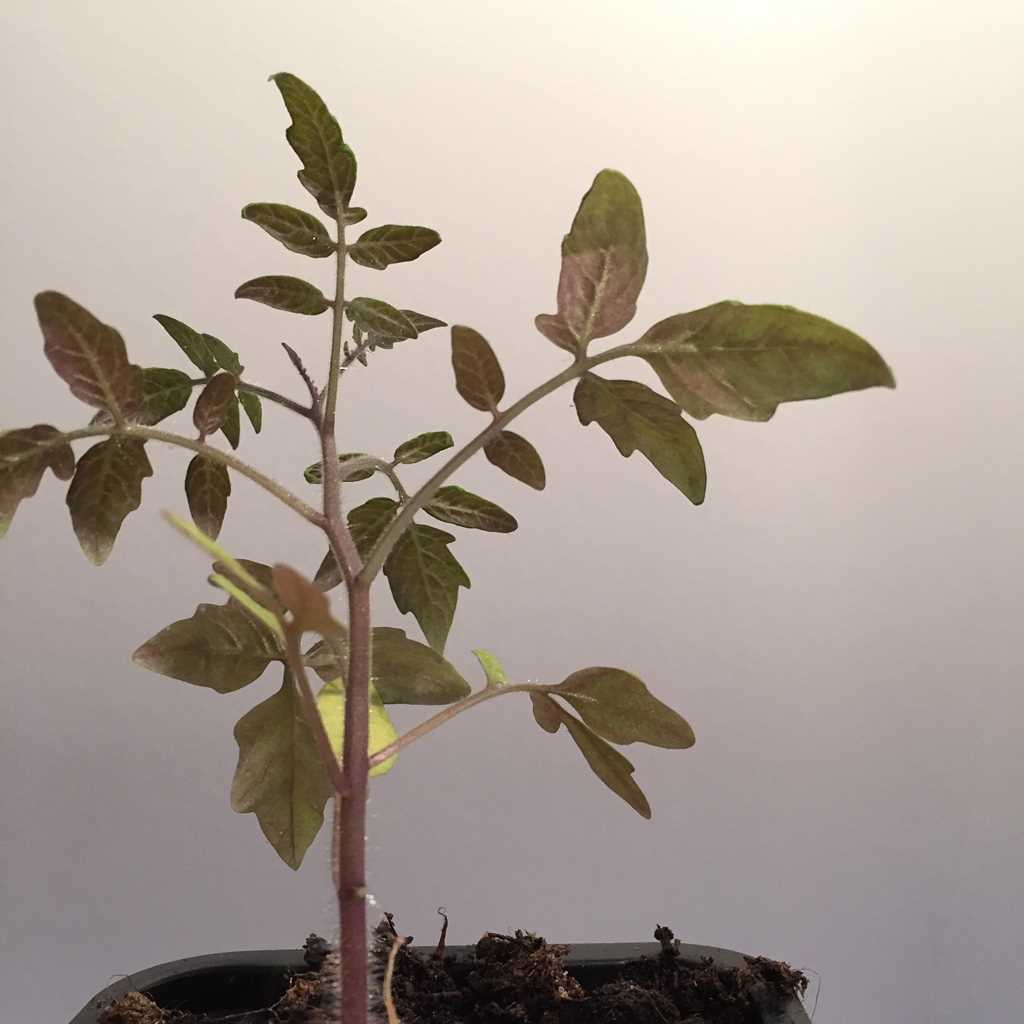
Tomato plants with purple leaves can be a cause for concern among gardeners. Purple leaves are often an indication of underlying issues that need to be addressed in order to ensure the health and productivity of your tomato plants. Here are some common causes of purple leaves in tomato plants:
- Nutrient Deficiency: One of the most common causes of purple leaves in tomato plants is nutrient deficiency, particularly a lack of phosphorus. Phosphorus is essential for proper plant growth and development, and a deficiency can result in purple leaves.
- Temperature Stress: Extreme temperature fluctuations, such as cold nights or hot days, can cause tomato plants to develop purple leaves. This is often a response to stress and can be mitigated by providing consistent temperature and proper shading.
- Pests and Diseases: Certain pests and diseases, such as aphids, spider mites, and fungal infections, can cause purple discoloration on tomato plant leaves. Regular monitoring and appropriate pest and disease management practices are crucial to prevent and control these issues.
- Genetic Factors: Some tomato varieties naturally have purple leaves due to their genetic makeup. If your tomato plant variety is known to have purple leaves, it may not necessarily indicate a problem or need for intervention.
It is important to properly diagnose the cause of purple leaves in your tomato plants in order to address the underlying issue and provide the necessary treatment. Consulting with a local horticulturist or extension office can provide valuable guidance and assistance in identifying and resolving the problem.
Symptoms of Purple Leaves
When tomato plants develop purple leaves, it is an indication that something is not right with the plant. The purple coloration can occur on the entire leaf or only on certain parts. Understanding the symptoms associated with purple leaves can help diagnose and treat the underlying issue.
Purple Veins
One common symptom of purple leaves in tomato plants is the presence of purple veins. The veins of the leaves turn purple while the rest of the leaf remains green. This can be an indication of phosphorus deficiency, caused by a lack of phosphorus in the soil or poor nutrient uptake by the roots.
Purple Leaf Edges
In some cases, the edges of the tomato plant leaves may turn purple while the rest of the leaf remains green. This can be a sign of cold stress, especially if the purple coloration is accompanied by wilting or browning of the leaves. Cold temperatures can hinder the plant’s ability to take up nutrients, leading to purple discoloration.
Purple Whole Leaves
In more severe cases, the entire leaf of the tomato plant can turn purple. This type of discoloration is often caused by a nutrient deficiency, particularly phosphorus or potassium. It can also be a sign of poor soil drainage or overwatering, which affects the plant’s ability to take up nutrients.
Purple Leaves with yellowing
When tomato plant leaves exhibit both purple coloration and yellowing, it can be an indication of nutrient deficiency or an underlying disease. Common nutrient deficiencies associated with this symptom include nitrogen and magnesium. Additionally, viral or bacterial infections can cause yellowing and purple discoloration of the leaves.
Purple Leaves in New Growth
If the new growth of tomato plants is coming in purple, it can be a sign of phosphorus deficiency. This is often caused by low soil temperatures, which inhibit phosphorus uptake. Poor root development or excessive fertilizer application can also contribute to this symptom. Ensuring proper soil temperature, improving root health, and following recommended fertilization practices can help address this issue.
| Symptoms | Possible Causes |
|---|---|
| Purple Veins | Phosphorus deficiency |
| Purple Leaf Edges | Cold stress |
| Purple Whole Leaves | Nutrient deficiency, poor soil drainage, overwatering |
| Purple Leaves with yellowing | Nutrient deficiency, viral or bacterial infections |
| Purple Leaves in New Growth | Phosphorus deficiency, low soil temperatures, poor root development, excessive fertilizer application |
Nutrient Deficiencies and Imbalances
Tomato plants may develop purple leaves as a result of nutrient deficiencies or imbalances. It is important to understand the specific nutrients that tomato plants require and how their absence or imbalance can lead to purple leaf discoloration.
1. Phosphorus Deficiency
A lack of phosphorus in the soil can result in purple leaves in tomato plants. Phosphorus is essential for energy transfer and the development of plant roots, flowers, and fruits. A deficiency of this nutrient can lead to stunted growth, reduced yields, and the development of purple or bronze-colored leaves. To address phosphorus deficiency, consider using a fertilizer with a higher phosphorus content or incorporating organic matter, such as bone meal or rock phosphate, into the soil before planting.
2. Potassium Deficiency
Insufficient potassium can also cause purple leaf discoloration in tomato plants. Potassium is crucial for overall plant health, promoting disease resistance, and regulating various physiological processes. A lack of potassium can result in poor fruit development, weakened stems, and purple or darkened leaves. To address potassium deficiency, apply a balanced fertilizer or incorporate organic matter, such as compost or wood ash, into the soil.
3. Magnesium Deficiency
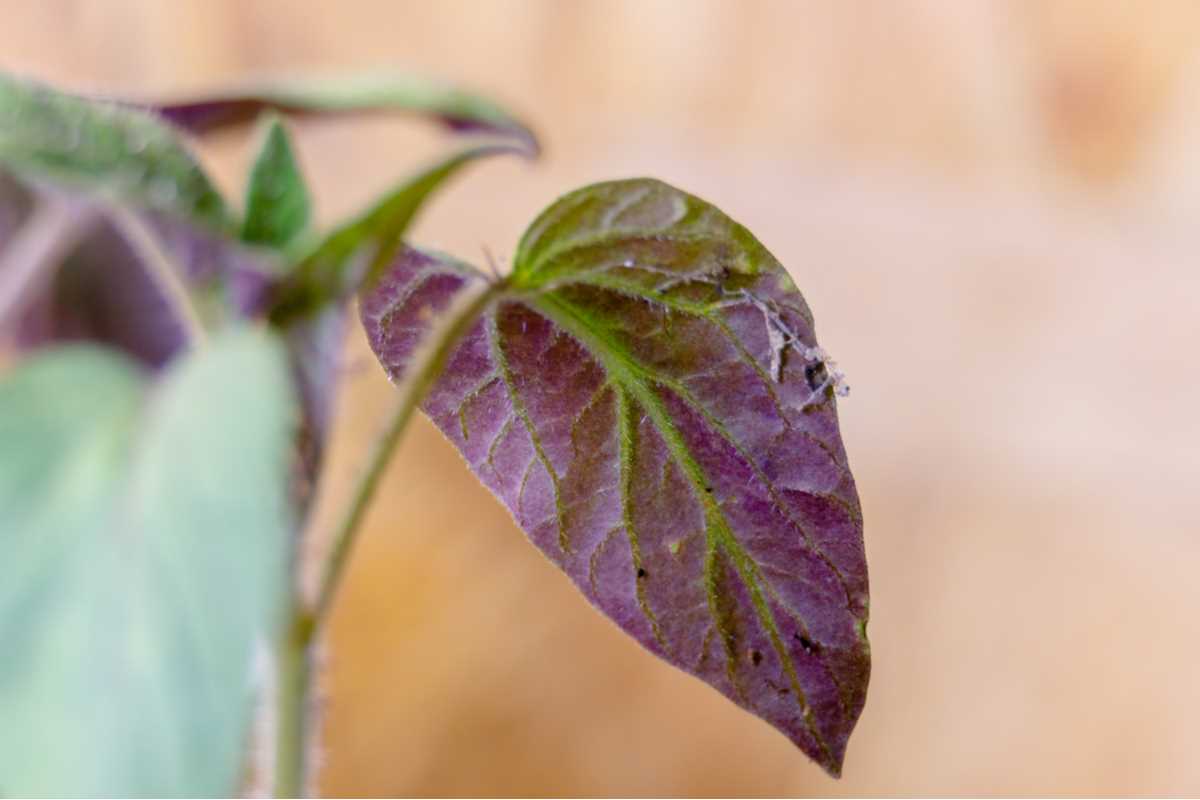
Magnesium deficiency can lead to interveinal chlorosis, a condition where the tissue between leaf veins turns yellow while the veins themselves remain green. In severe cases, the leaves may develop a purple or reddish hue. Magnesium is responsible for chlorophyll production and photosynthesis, so a lack of this nutrient can significantly affect plant growth. To address magnesium deficiency, apply magnesium sulfate or Epsom salts to the soil or use a fertilizer formulated with magnesium.
4. Calcium Deficiency
While calcium deficiency is not directly responsible for purple leaves, it can lead to physiological disorders such as blossom end rot. Blossom end rot, characterized by dark, sunken areas on the bottom of fruits, can cause purple discoloration in affected areas. Calcium is essential for cell wall development and proper plant structure. To prevent calcium deficiency, ensure a consistent supply of calcium to tomato plants by incorporating lime or gypsum into the soil.
5. Micronutrient Imbalances
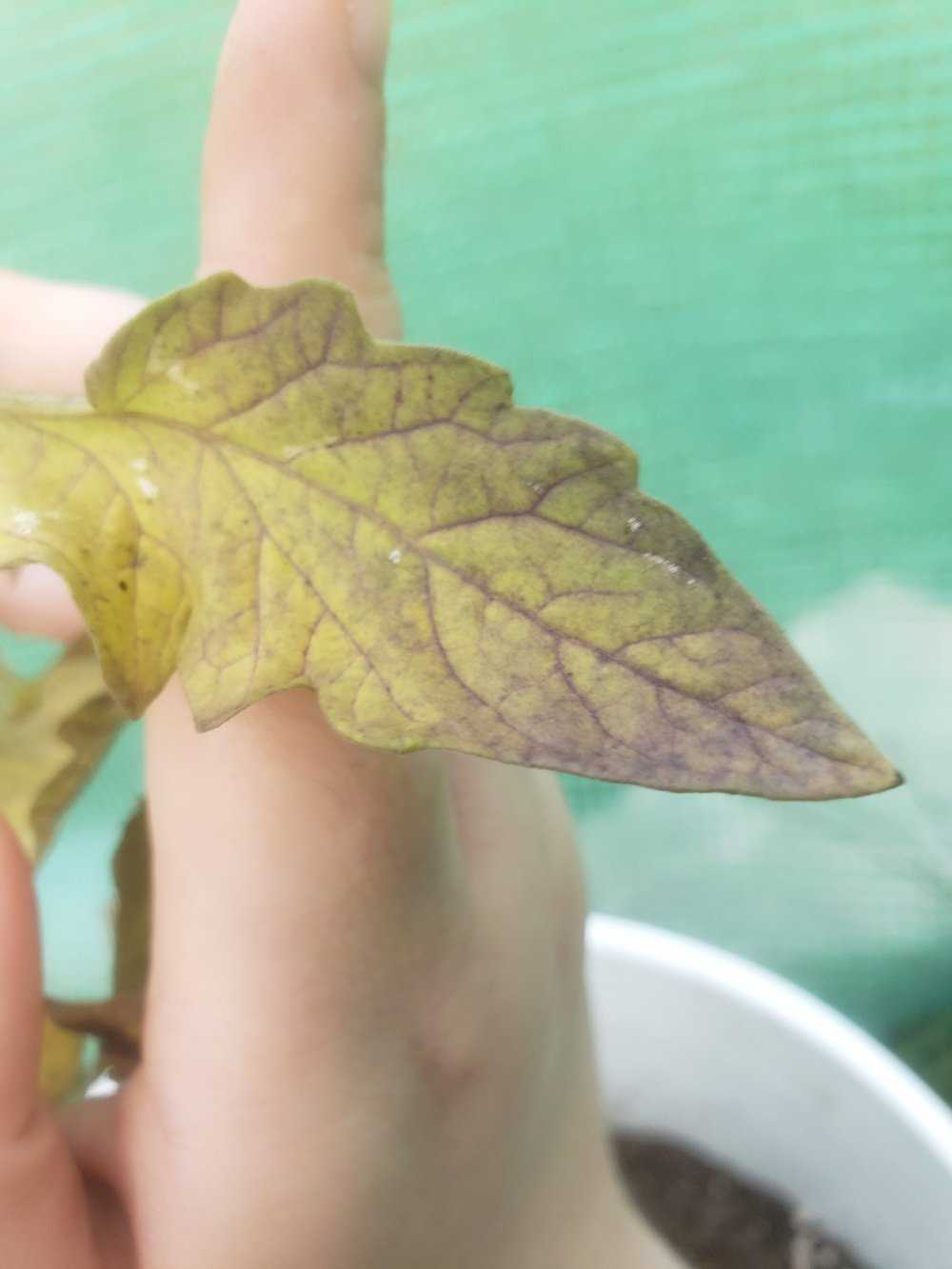
In addition to macronutrient deficiencies, imbalances in micronutrients can also contribute to purple leaf discoloration. These include iron, zinc, manganese, and copper. It is important to maintain a proper balance of these micronutrients as excessive levels can be toxic to plants. Soil testing can help identify micronutrient imbalances, and the use of balanced fertilizers or foliar micronutrient sprays can help address these issues.
Conclusion
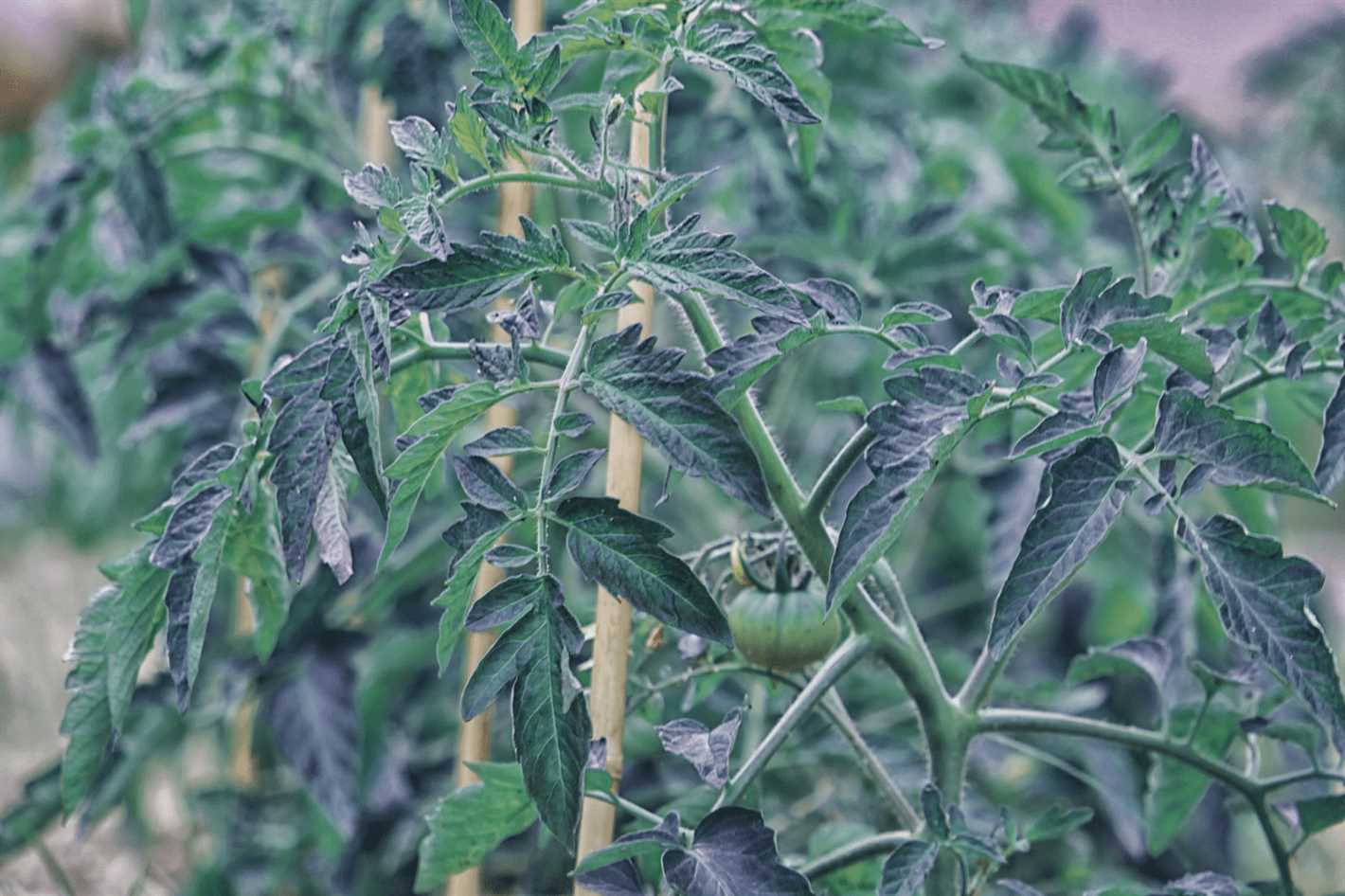
Purple leaves in tomato plants can indicate nutrient deficiencies or imbalances. By understanding the specific nutrient requirements of tomato plants and how their absence or imbalance can lead to purple leaf discoloration, it becomes easier to diagnose and address these issues. Proper soil preparation, balanced fertilization, and regular monitoring of plant health can help ensure healthy tomato plants with vibrant green leaves.
Environmental Factors
Tomato plants with purple leaves can be caused by various environmental factors. It is important to identify and address these factors in order to prevent and treat the issue. Here are some common environmental factors that can affect the color of tomato leaves:
- Temperature: Extreme temperatures, both hot and cold, can cause tomato leaves to turn purple. Tomato plants are sensitive to temperature fluctuations, and their leaves may change color as a stress response. Maintaining a consistent temperature and providing adequate protection, such as using row covers or shading, can help prevent purple leaves.
- Light: Insufficient or excessive light can also lead to purple leaves in tomato plants. Too much direct sunlight can cause sunburn, which manifests as purple or brown patches on the leaves. On the other hand, insufficient light can result in a buildup of anthocyanins, pigments responsible for the purple color. Providing the plants with proper lighting conditions, such as partial shade or artificial lighting, can help prevent leaf discoloration.
- Nutrient Deficiencies: Tomato plants require a balanced supply of nutrients to grow and develop properly. Deficiencies in essential minerals, such as phosphorus, potassium, or magnesium, can cause the leaves to turn purple. Conducting a soil test and providing appropriate fertilization can help address nutrient deficiencies and restore the normal color of the leaves.
- Watering: Improper watering practices, such as over-watering or under-watering, can stress tomato plants and cause leaf discoloration. Over-watering can lead to oxygen deprivation in the roots, resulting in purple leaves. Conversely, under-watering can cause the plant to take up more nutrients than it needs, leading to nutrient imbalances and purple leaves. Maintaining a consistent watering schedule and monitoring the moisture levels in the soil can help prevent these issues.
- Pesticides and Chemicals: Exposure to certain pesticides or chemicals can also cause tomato leaves to turn purple. It is essential to follow proper application guidelines and avoid using chemicals that can be harmful to the plants. Organic or natural alternatives can be considered to minimize the risk of leaf discoloration.
In conclusion, understanding and addressing the environmental factors that contribute to purple leaves in tomato plants is crucial for their overall health and productivity. By providing optimal growing conditions and taking necessary precautions, gardeners can prevent and resolve leaf discoloration issues, ensuring vibrant and healthy tomato plants.
Tomato Varieties Prone to Purple Leaves
While purple leaves on tomato plants can be a sign of nutrient deficiencies or other problems, there are certain tomato varieties that are more prone to developing purple leaves than others. It is important for gardeners to be aware of these varieties and take appropriate measures to prevent or address the issue.
1. Cherokee Purple
This heirloom variety is known for its unique and delicious flavor, but it is also notorious for developing purple leaves. The leaves may turn purple due to cold temperatures, exposure to excessive sunlight, or lack of phosphorus.
2. Black Krim
Another popular heirloom tomato variety, Black Krim is known for its deep, rich flavor. However, it is also known for its tendency to develop purple leaves, especially in cooler temperatures. Providing adequate phosphorus and maintaining stable temperatures can help prevent this issue.
3. Marmande
An indeterminate variety with large, juicy tomatoes, Marmande is prone to developing purple leaves under certain conditions. Providing sufficient potassium and phosphorus, and ensuring consistent temperatures, can help prevent the leaves from turning purple.
4. Indigo Rose
This unique variety is known for its purple-colored fruits, but it can also develop purple leaves. The purple color in both the fruit and the leaves comes from anthocyanins, which are natural pigments. However, if the leaves become excessively purple, it may indicate a phosphorus deficiency.
5. Black from Tula
This Siberian variety is famous for its complex, smoky flavor, but it is also prone to developing purple leaves. Exposure to cold temperatures and lack of phosphorus can cause the leaves to turn purple. Providing adequate phosphorus and protecting the plants from extreme cold can help prevent this issue.
In conclusion, while some tomato varieties are more prone to developing purple leaves than others, it is important for gardeners to monitor their plants and address any potential nutrient deficiencies or environmental factors that may be causing the issue. By providing the necessary nutrients and maintaining optimal growing conditions, gardeners can help their tomato plants thrive and produce healthy green leaves.
Treating Purple Leaves
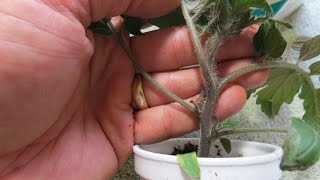
Purple leaves on tomato plants can be an indication of several issues, including nutrient deficiencies, diseases, or environmental stress. It is important to identify the underlying cause of the purple discoloration in order to effectively treat the plants.
1. Nutrient Deficiencies
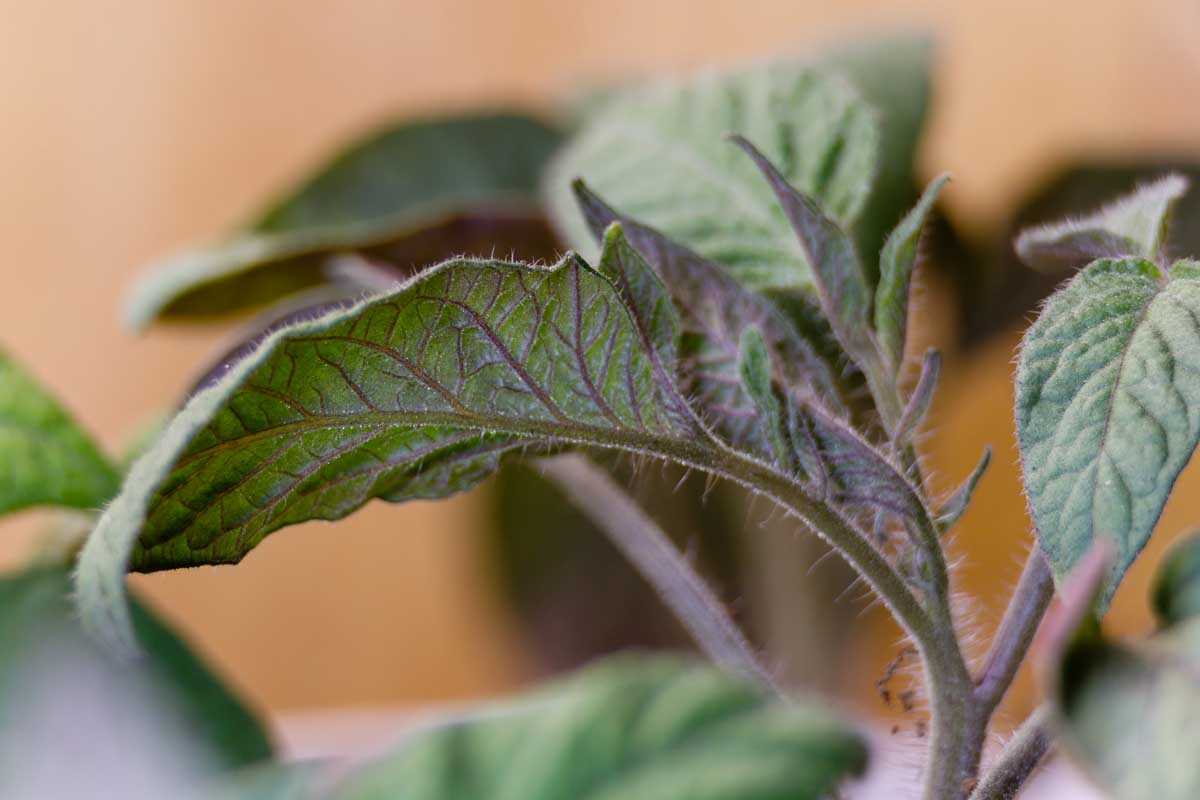
Purple leaves can often be a sign of nutrient deficiencies in tomato plants. Here are some common deficiencies and their symptoms:
- Phosphorus Deficiency: Purple leaves, particularly on the lower parts of the plant. Stunted growth.
- Potassium Deficiency: Purple or bronze leaves, especially on the edges. Yellowing between veins.
- Magnesium Deficiency: Purple or reddish leaves, starting from the lower parts of the plant. Yellowing between veins.
If you suspect a nutrient deficiency, it is important to test the soil pH and nutrient levels. Adjusting the soil pH and providing appropriate fertilizers can help resolve nutrient deficiencies.
2. Diseases
Some diseases can also cause purple leaves in tomato plants. Here are a few common diseases and their symptoms:
- Tomato Leaf Curl Virus: Purple or yellow leaves, curling of the leaves, stunted growth.
- Tomato Spotted Wilt Virus: Purple or bronze mottling on leaves, yellowing, necrotic spots.
- Early Blight: Purple spots on leaves, followed by dark concentric rings and yellowing.
If you suspect a disease, it is important to remove and destroy infected plants to prevent further spread. Applying appropriate fungicides or contacting a professional plant pathologist may also be necessary.
3. Environmental Stress
Environmental stressors such as extreme temperatures or inadequate water can cause purple leaves in tomato plants. Here are some common stressors and their effects:
- Cold Temperatures: Purple discoloration on leaves due to reduced nutrient uptake.
- Hot Temperatures: Purple leaves as a protective response to heat stress.
- Drought Stress: Purple leaves as a result of reduced water uptake.
To avoid environmental stress, ensure proper watering and temperature regulation. Providing shade or mulching can also help protect the plants from extreme temperatures.
Conclusion
In conclusion, treating purple leaves on tomato plants requires identifying the underlying cause, whether it be nutrient deficiencies, diseases, or environmental stress. Take appropriate steps such as adjusting soil pH, providing fertilizers, removing infected plants, and addressing environmental stressors to treat and prevent purple leaves in tomato plants.
Prevention and Maintenance
In order to prevent tomato plants from developing purple leaves, it is important to maintain a proper growing environment and provide them with the necessary nutrients. Here are some preventive measures and maintenance tips:
1. Soil Preparation and Fertilization
- Before planting the tomato seedlings, make sure the soil is well-draining and rich in organic matter. Amend the soil with compost or well-rotted manure to improve its fertility.
- Test the soil pH and adjust it to a range of 6.0 to 6.8, as tomatoes prefer slightly acidic soil.
- Provide regular fertilization to ensure the plants receive sufficient nutrients. Use a balanced fertilizer or a tomato-specific fertilizer according to the package instructions.
2. Watering
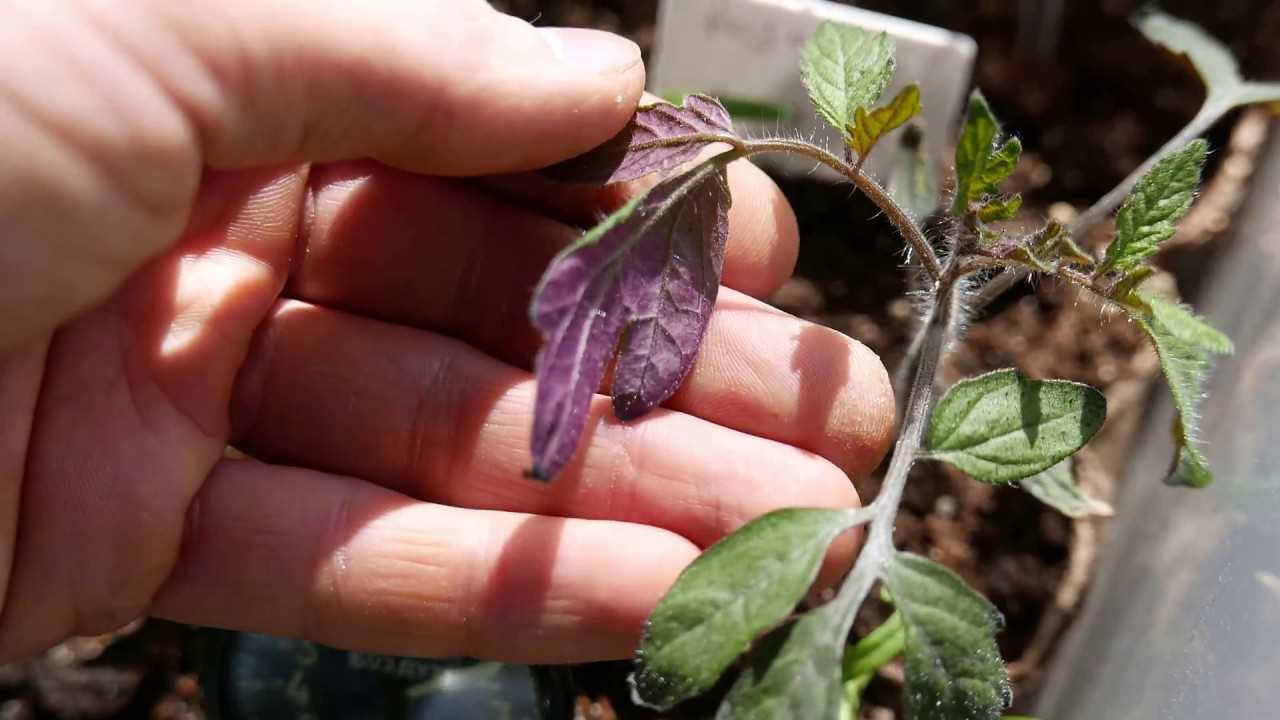
- Tomato plants require consistent and adequate watering, especially during dry periods.
- Water the plants deeply to encourage the development of a strong root system.
- Avoid overwatering, as excessive moisture can lead to root rot and other diseases.
- Consider using a drip irrigation system or soaker hoses to provide a steady supply of water directly to the roots.
3. Proper Plant Spacing
- Avoid overcrowding tomato plants, as this can create competition for resources and increase the risk of disease spread.
- Follow the recommended spacing guidelines to ensure adequate air circulation and sunlight penetration between the plants.
4. Crop Rotation
- Practice crop rotation by avoiding planting tomatoes in the same spot year after year. This helps reduce the risk of soil-borne diseases and nutrient imbalances.
- Rotate tomatoes with unrelated crops such as legumes, leafy greens, or root vegetables.
5. Pest and Disease Management
- Regularly inspect tomato plants for signs of pests or diseases, such as aphids, tomato hornworms, or fungal infections.
- Remove any affected leaves or fruits immediately to prevent the spread of disease.
- Consider using organic pest control methods, such as neem oil or insecticidal soap, to manage pest infestations.
6. Staking and Pruning
- Support tomato plants by staking or trellising them to keep the leaves off the ground.
- Prune the plants regularly to remove any suckers or unproductive growth, which can divert energy away from fruit production.
By following these preventive measures and performing regular maintenance tasks, you can help ensure healthy tomato plants with vibrant green leaves, free from the purple discoloration.
“Question-Answer”
What does it mean if my tomato plant has purple leaves?
If your tomato plant has purple leaves, it could be a sign of several different issues. One possible cause is nutrient deficiency, particularly a lack of phosphorus. Another cause could be a fungal disease called Verticillium wilt. It is also possible that the purple coloration is simply a genetic trait of the particular variety of tomato plant you are growing.
How do I know if my tomato plant has a phosphorus deficiency?
If your tomato plant has a phosphorus deficiency, you may notice purple or reddish-brown discoloration on the leaves, particularly on the underside. The leaves may also appear stunted or curled. To confirm the diagnosis, you can also conduct a soil test to measure the nutrient levels in your soil.
Can I treat a phosphorus deficiency in my tomato plant?
Yes, you can treat a phosphorus deficiency in your tomato plant by applying a phosphorus-rich fertilizer. Look for a fertilizer with a high middle number on the label, as this indicates a higher phosphorus content. You can also amend your soil with bone meal or rock phosphate, which are natural sources of phosphorus.
What is Verticillium wilt and how can I treat it?
Verticillium wilt is a fungal disease that affects tomato plants. It is characterized by purple or brown discoloration of the leaves, wilting, and yellowing of the lower leaves. The fungus can live in the soil for many years, so it is important to practice crop rotation to prevent its spread. There is no cure for Verticillium wilt, so infected plants should be removed and destroyed to prevent the disease from spreading.
Can I prevent my tomato plants from developing purple leaves?
While genetic factors may cause some tomato plants to naturally have purple leaves, there are steps you can take to minimize the risk of nutrient deficiencies and diseases that can cause purple coloring. Make sure to provide your plants with a balanced fertilizer and monitor their nutrient levels regularly. Additionally, practicing good garden hygiene and crop rotation can help prevent the development of fungal diseases like Verticillium wilt.
Are there any tomato varieties that are more prone to developing purple leaves?
Yes, certain tomato varieties are more likely to develop purple leaves compared to others. As this genetic trait is specific to each variety, it is important to choose tomato varieties that are known to have green leaves if you want to avoid purple coloring. Reading seed catalogs or consulting with local horticultural experts can help you find green-leaved tomato varieties that are less prone to developing purple leaves.
Can overwatering cause tomato plants to have purple leaves?
Yes, overwatering can contribute to the development of purple leaves in tomato plants. When plants are overwatered, their roots may become waterlogged and struggle to absorb nutrients, leading to nutrient deficiencies like a lack of phosphorus. To avoid overwatering, make sure to allow the soil to dry out between waterings and use well-draining soil or containers.







